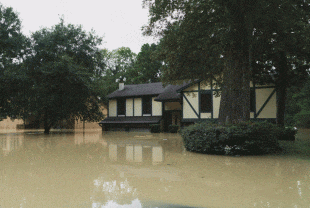New research from Rice University sociologists finds that flood victims are likely to resettle in flood-prone areas, so long as their new neighborhoods are whiter and wealthier than where they used to live.
Kevin Loughran, a postdoctoral research fellow in Rice’s Department of Sociology, and James Elliott, a professor and the department’s chair, tracked more than 1,700 participants in the first large-scale study of where participants in the federal buyout program move.
“We were interested in what their actions can tell us about a growing but understudied policy to combat climate change,” Loughran said.
The Federal Emergency Management Agency’s Hazard Mitigation Grant Program allows homeowners to relocate from flood-prone areas by selling their homes to a local government agency. Using federal funding, the local agency then demolishes the home, reducing the number of households at future risk. That policy, now adopted by more than 500 U.S. cities, is touted as a cost-effective strategy that can help the National Flood Insurance Program remain fiscally solvent.
But it is also something more, the researchers said: it is the leading federal policy promoting environmental migration.
Analyzing data from Harris County, Texas — the central county of the Houston metro area and one of the largest sites of federal buyouts — Loughran and Elliott found that while the environmental impacts of buyouts as a flood-control measure are ambiguous, the social impacts are very clear.
While buyouts offer flood mitigation benefits, they also finance relocation that in many ways differs little from moves that are motivated by the prospect of upward social mobility, the researchers said.
The study revealed that 90% of participating homeowners resettled within the Houston metro area despite widespread flood risks, reflecting the pull of existing social networks, jobs and school districts. They were also much more likely to resettle within their same flood-prone neighborhood if it was predominantly white and higher-income.
And homeowners in the buyout program who did move outside their original neighborhoods were more willing to move into other flood-prone areas if those areas were significantly whiter and wealthier than their old neighborhoods. On average, participants in the Harris County buyout program moved to nearby destinations that were 34% whiter and 32% wealthier than their old neighborhoods.
The researchers said these findings raise important questions about the effects of federal buyout policy on racial and class inequalities.
“It seems that people are willing to tolerate personally experienced, publicly identified and ongoing urban flood risks if they can maintain or even upgrade their neighborhood’s socio-economic status,” Loughran said. “In this way, the federal policy seems to facilitate a process of
residential mobility that challenges the official framing of the policy as just flood control.”
“These insights refine our understanding of what environmental migration is in the U.S.,” Elliott said. “Generally speaking, it’s not about long-distance, involuntary resettlement of the type highlighted in other parts of the world. It’s about unequal opportunities to voluntarily move to better neighborhoods in one’s local area.”
The research draws on a dataset assembled by Loughran and Elliott, with assistance from Allison Yelvington from Rice and Aubrey Calaway from Brown University. Of the 3,076 buyouts that were administered locally by the Harris County Flood Control District prior to Hurricane Harvey in 2017, the researchers were able to locate 75% of the destination addresses for individual (noncorporate) participants. The resulting dataset, which served as the basis for their study, enables address-level analysis of environmental mobility for the first time in social-scientific research.
The paper, “Residential Buyouts as Environmental Mobility: Examining Where Homeowners Move to Illuminate Social Inequities in Climate Adaptation,” was published in a recent edition of Population and Environment.


